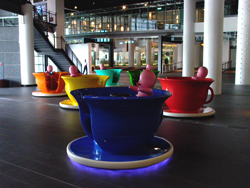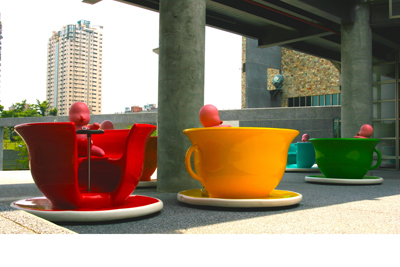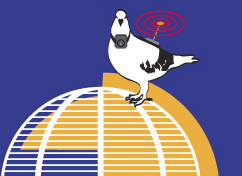Shu Lea Cheang  BABY LOVE is a National Taiwan Museum of Fine Arts commission with support from Council for Culture Affairs, Taiwan and Taipei Cultural Center,TECO in New York in collaboration with SQV Design International Tatung University, Mechanical Engineering departmen eLife Techonology Innovation Center Sony Computer Science Laboratory Paris. BABY LOVE is the second installment of Shu Lea Cheang's Locker Baby Project which also includes BABY PLAY (presented at NTT[ICC], Tokyo in 2001) and BABY WORK (to be realized). Referring to Ryu Murakami's noted novel Coin Locker Babies (1980), the updated locker babies are borne out of Tokyo coin lockers by DPT (DollyPolly Transgency) with genes extracted from deep-sea pearls. The biobot locker babies are the clone generation of our sci-fi fantasia reality, entrusted to receive, store, transmit and negotiate human memory and emotions. BABY LOVE situates human and its baby clones in a perpetual spin of fairground teacup ride. Love songs uploaded by public via the web and USB interface are coded as ME (memory and emotion) data for the clone babies. By taking a teacup ride with the babies, the ME data are retrieved, jumbled and eventually crashed.
 BABY LOVE is a mobile wifi installation that consists of 6 large size (170 cm diameter) teacups and 6 clone babies (70 cm tall). The teacup modeled after the spinning teacup of the old-time playground is made into an auto-mobile unit. The baby adorned with a locker key, a LED display with random locker numbers, is installed with a baby machine (a Mac mini with 802.11 wifi connection). The spinning wheel on the teacup is wired with sensors. The sensor data (direction and speed) sent via RS 232 and 802.11 to the baby commands the baby machine. The baby machine, its sound engine written in MaxMSP, receives and processes MP3 database. When riding the teacup, its direction maneuver and speed variation shuffle and rearrange the love songs in the baby engine. The teacup's bottom plate inflated with a silicon tube encloses a circular strip of contact bumper. When teacups are bumped into each other, the baby engine is informed, sound files are exchanged and remixed for web streaming. In BABY LOVE, Shu Lea Cheang continues her research in current net culture practices. A series of her work explore issues on P2P commons and shared network (Kingdom of Piracy), wifi public domain (RICHAIR2030 by TAKE2030) and ubiquitous network (PORTA2030 by TAKE2030). BABY LOVE in its prime color pop design is planned for open public space with wifi commons. Its mechanism drives the interactivity and links to the Netivity. The teacups liberated from the central mechanism platform operate in distributed network concept. The Net is now our largest depository of ME data (including blog publishing, mp3s, mpgs, sound and fury). But, who holds the key to unlock the ME? Links: http://babylove.biz |
